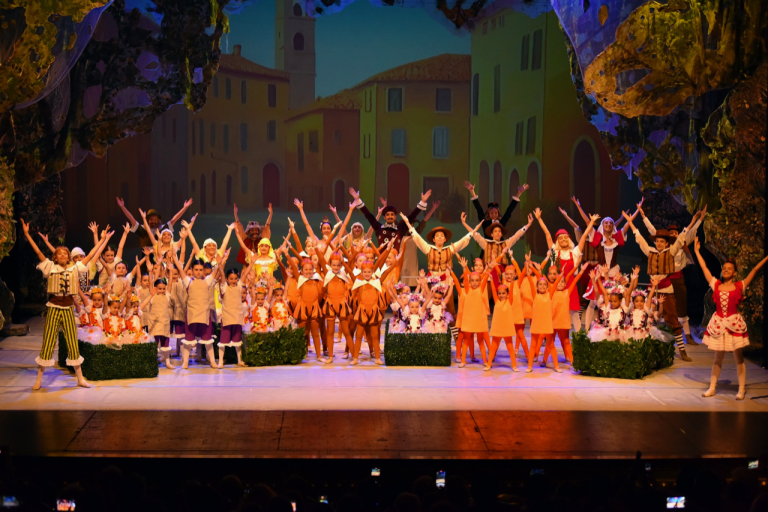
Bullfrogs Ballet
Bullfrogs Ballet students in North Macedonia bow at the end of a performanceBy REESE CARLSON
Capital News Service
LANSING – Pirouettes, leaps and pliés don’t come to mind when you think of environmental justice.
But for Michigan State University theater professors Deric McNish and Rob Roznowski, dance and theater are perfect communicative devices for such serious topics.
“The cultural impact of creating artistic work with social justice behind it could be huge,” Roznowski said.
MSU theater students in East Lansing and a North Macedonian ballet company, Bullfrogs Ballet, are collaborating on the Ripple Effect, a project funded by a $20,000 grant from the U.S. Embassy and MSU’s Office of Research and Innovation. It addresses environmental issues that both North Macedonians and Michigan residents face, like water and industrial pollution.
North Macedonia is in southeastern Europe, almost 5,000 miles from Michigan.
“Our students will be put in contact with North Macedonian art students, dance students, theater students,” McNish said. “We’re going to have conversations about the similar environmental problems we’re facing, the potential solutions and what role the arts can play.”
Michigan State students of all majors can enroll next fall in a class created for the Ripple Effect, McNish said, and they don’t have to be a dancer.
“The students will decide what aspects about water, water security, water pollution, etc. matter most to them and the community,” Roznowski said. “We will create different theatrical styles and acts designed to communicate those issues.”
Bullfrogs Ballet is a dance company in Skopje, North Macedonia for dancers ages 5-25, but this program focuses on the age group closest to the MSU students.
The grant will cover the cost for Roznowski and McNish to travel to North Macedonia to work directly with the ballet students. North Macedonian ballet instructors will then travel to East Lansing to workshop with the MSU theater students, McNish said.
“I was doing a similar project with the U.S. Embassy in Russia when I saw the U.S. Embassy in Skopje (the capital) was advertising interest in doing a project with the arts and social justice,” McNish said. “I immediately reached out because that’s what I do here at Michigan State.”
Depending on what the students decide, the project could look different. Dances will be choreographed to represent the issues they choose. There could be props related to the environmental topics the students pick, McNish said.
Social and environmental justice experts in North Macedonia and the United States will be consulted for the project, Roznowski said, and will help bridge the gap between the arts and environmental justice.
Amber Pearson, an MSU associate professor of geography, is the social justice consultant on the Michigan side of the project.
“Water insecurity is an often-ignored problem faced in many places, including the United States,” Pearson said. “Many people across the world lack safe, reliable, sufficient or affordable water for a thriving life.”
Pearson researches how physical and social environments improve health, often in the face of socioeconomic adversity.
McNish said, “The idea is that you can get young students to engage with these topics through an art form that interests them, dance or theater, for example. This creates interest and draws focus to the topic, especially when the public comes to view the end product.”
Dancing has been scientifically explored as a form of justice and communication. A 2018 article by Columbia University graduate and performer Sadi Mosko, published in Consilience Journal, considers the idea that dance is a universal language and can be used to communicate complicated topics, like environmentalism and climate injustice.
The article looked at studios that employ unique forms of dance to communicate scientific concepts and how they were received.
One used dirt and water as a part of a performance to convey the human connection with nature. As the dance progresses, the dirt eventually plays the part of prop, set, costume and performer.
People who are not knowledgeable about science are more likely to engage in scientific topics when they are presented unconventionally, like through dance, Mosko reported. Dance puts the concepts into a new context without using statistics or threatening another world-shattering disaster.
Viewers are led to reconsider their views on their own terms.
McNish and Roznowski said they hope the Ripple Effect inspires further environmental theater.
The hope is to get an artistic community that crosses borders to take an issue like the environment and create art that prompts communities to talk about it, McNish said.
“That’s something sustainable and would allow other people to become involved in these issues.”
The Ripple Effect is scheduled to debut in November as a live stream from North Macedonia and East Lansing.
Reese Carlson writes for Great Lakes Echo.